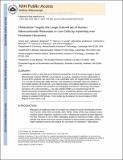Clofarabine Targets the Large Subunit (α) of Human Ribonucleotide Reductase in Live Cells by Assembly into Persistent Hexamers
Author(s)
Aye, Yimon; Long, Marcus J.C.; Chittuluru, Johnathan; Asturias, Francisco J.; Stubbe, JoAnne; Brignole, Edward J; Drennan, Catherine L; ... Show more Show less
DownloadDrennan_Clofarabine targets.pdf (2.105Mb)
PUBLISHER_POLICY
Publisher Policy
Article is made available in accordance with the publisher's policy and may be subject to US copyright law. Please refer to the publisher's site for terms of use.
Terms of use
Metadata
Show full item recordAbstract
Clofarabine (ClF) is a drug used in the treatment of leukemia. One of its primary targets is human ribonucleotide reductase (hRNR), a dual-subunit, (α2)m(β2)n, regulatory enzyme indispensable in de novo dNTP synthesis. We report that, in live mammalian cells, ClF targets hRNR by converting its α-subunit into kinetically stable hexamers. We established mammalian expression platforms that enabled isolation of functional α and characterization of its altered oligomeric associations in response to ClF treatment. Size exclusion chromatography and electron microscopy documented persistence of in-cell-assembled-α6. Our data validate hRNR as an important target of ClF, provide evidence that in vivo α's quaternary structure can be perturbed by a nonnatural ligand, and suggest small-molecule-promoted, persistent hexamerization as a strategy to modulate hRNR activity. These studies lay foundations for documentation of RNR oligomeric state within a cell.
Description
Available in PMC 2013 July 27
Date issued
2012-07Department
Massachusetts Institute of Technology. Department of Biology; Massachusetts Institute of Technology. Department of ChemistryJournal
Chemistry & Biology
Publisher
Springer Science + Business Media B.V.
Citation
Aye, Yimon, Edward J. Brignole, Marcus J.C. Long, Johnathan Chittuluru, Catherine L. Drennan, Francisco J. Asturias, and JoAnne Stubbe. “Clofarabine Targets the Large Subunit (α) of Human Ribonucleotide Reductase in Live Cells by Assembly into Persistent Hexamers.” Chemistry & Biology 19, no. 7 (July 2012): 799-805.
Version: Author's final manuscript
ISSN
10745521